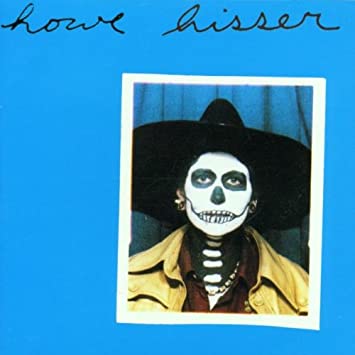Nobel prize winner for literature, Bob Dylan, wrote on one of his less accomplished albums, Shot of Love, the following:
…onward in my journey I come to understand
– Bob Dylan, “Every Grain of Sand”
That every hair is numbered like every grain of sand
It might be hard to say how much these words were intended for Howe Gelb, one of the quiet heroes of modern music, but the phrase every grain of sand certainly might.
It seems that sand in any shape and form permeates Gelb’s work in the last 40 years or so. Particularly that part when sand enters something it is hard to shake it all out, whether you want it or not. Particularly the natural fact that when it starts spreading it goes everywhere.
And that is exactly what Gelb did with his music. It went everywhere, and it is still going in all directions possible. From punky electro-pop in the beginning to modern country rock and Americana in all shapes and forms to jazz experimentation, crooning, gospel, flamenco… you name it. After all, Gelb’s main musical vehicle(s) for years were Giant Sand, Giant Sandworms, Giant Giant Sand…
Of course, it is not all in the name, but in the feel, emotion, and concept(s) that stem from them. With Howe Gelb, sand, its constant movement, the ability to slip out of your hand and then reappear out of nowhere, is as that biggest British band once said, “here, there and everywhere…”
From Pennsylvania to Arizona’s (Sand)Man of the World
Maybe Gelb was born in Pennsylvania, but wherever he goes, whatever he does, he brings along the feel, the atmosphere of the actual home (currently, one of them, at least) that seems to lay in his heart the most, and that is Tucson, Arizona.
Gelb moved there when his home in Wilkes-Barre, a small factory/coal town in Pennsylvania got destroyed by a flood. And while he moved around during his 40 years on the music scene, and due to his family situation, spends part of every year in Denmark (his current wife is Danish), it seems that all that describes Tucson permeates his music. The heat, the relaxed atmosphere that often borders on melancholy it creates, the open wide spaces, and, of course, the sand that is practically everywhere, even if you don’t see it.

It seems that all that describes Tucson permeates his music
Gelb’s first musical venture was The Giant Sandworms, which started back in 1979 and with only one EP released a year later. Still, it was an important musical milestone, not for the slim recorded music this electro-rock outing came up with, but because it was mainly a collaboration between Gelb and late slide guitar maestro Rainer Ptacek, with whom Gelb had, and probably still has a spiritual bond.
That bond was so strong that Gelb organized a tribute album to help Ptacek cover the expenses of his fight with brain cancer while he was still alive (The Inner Flame: A Tribute to Rainer Ptacek, 1997 and its re-worked version from 2012) that included such names as Robert Plant, Jimmy Page, Lucinda Williams, and Jonathan Richman – among others. But even more so, after Rainer’s passing, Gelb produced Hisser(1998), one of his most intense and most somber albums, as a personal tribute to Ptacek.
Giant Sand – Turning Country Rock into Americana
Sure, you can pin the creation of Americana as a music genre to rock names like Dylan, Neil Young, The Byrds, and country names like Townes Van Zandt. But, in many ways, it was Howe Gelb and his Giant Sand that helped create its current shape and form, all the way back in the early ’80s until Gelb decided to lay the group to rest in 2016, practically 30 years after Valley of Rain (1985), its first album, released.
In many ways, it was Howe Gelb and his Giant Sand that helped create its current shape and form
As the years progressed, one concept started to dominate in Gelb’s vision of music – anything’s possible, as long as one red thread permeates everything. In a 2004 interview with Gelb, British daily The Guardian wrote “Gelb’s way of dealing with it was to treat Giant Sand as a loose, uncompetitive, mutually supportive musical collective, a place for friends to hang out and play. ‘I just liked the idea of having this kind of removed world, this brotherhood—the idea of a band being something more than a front person or dealing with the throes of fame.'”
And fame never came to Giant Sand. Or Howe Gelb for that matter. But it certainly did to some of the more (or less) constant members of the band. Giant Sand’s longtime rhythm sections of Joey Burns and John Convertino gained fame with Calexico, a band that focused on one aspect of music Gelb developed with Giant Sand or with his other incarnations. Gelb was also instrumental in discovering Granddaddy and M.Ward (whose first album Gelb released) and he helped many other artists boost their musical careers, including Scottish singer/songwriter KT Tunstall and Dutch actress Carice Van Houten (Game of Thrones).
Albums Turn into Grains of Sand
You can ask Gelb how many albums he released solo with all the bands he was in or as collaborations in these 40 years or so, but he himself wouldn’t be able to tell you. 40 might be the number, but then it might be not be. At some point, Gelb ran a sort of Grateful Dead-like tape exchange through his website where ardent fans posted concert tapes.
And as with The Dead, there was a good reason for that. Even if Gelb did a song that was familiar to fans, it never sounded the same, sometimes it was in a completely different shape or form; and that was not just true with the live shows, but also for studio recordings, since Gelb often re-works his compositions from album to album, giving them a completely new sound.
This shapeshifting (sand dunes, anybody?) is actually one of Gelb’s main musical characteristics. Gelb always comes up with some wild musical concept that always seems to work. He takes the music from almost complete shambles, that somehow never fall apart, to exquisite touches, usually at least twice in each and every song.
He tackled practically everything – from Americana experimental jazz (try on Giant Sand’s “Long Stem Rant” for size), country ‘as is’ (The Band of Blacky Ranchette’s two albums), to cocktail American songbook style stuff (OP8’s only album Slush or his more recent solo outing, Future Standards); gospel soul (Sno Angel Like You” [2006]) or Gypsy Kings-style flamenco (Alegrías [2008]).
Gelb always comes up with some wild musical concept that always seems to work
If you search through Gelb’s voluminous catalog, you will probably find something unexpected, yet another certainty with Gelb. If you need some sort of summation of Gelb’s work in one album (if such a thing is possible) then your best bet would be Giant Giant Sand’s only release with an almost expected title – Tuscon. There he covers at least part of the musical ground he covered in 40 years or so, including showing Calexico what real AmMex music should really sound like (“Cariñito”).
Still, with all the influences, collaborations, fandom among more renowned artists, and vast bodies of work, Howe Gelb somehow remains in that grey area between light and shadows. It is quite possible he wants it to stay that way.




